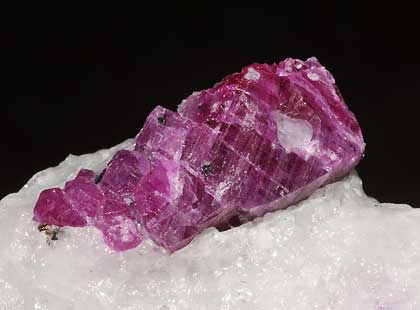Birthstones by the Month
The July Birthstone is Ruby
Ruby Mineral Form
Ruby is the gem quality variety of the mineral Corundum and is the only red Corundum, colored by the presence of chromium.
Sapphire is the other gem variety and covers the rest of the color spectrum, though is most notably associated with blue.
Rubies and Sapphires are the same in their mineral properties except for the color. Corundum is specifically an aluminum oxide with a hexagonal crystal structure.
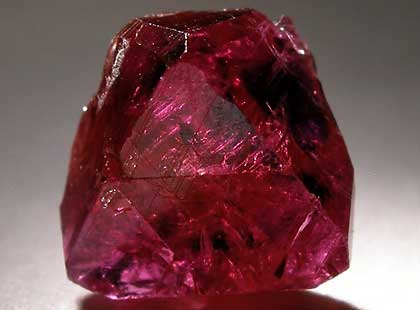
Ruby Doubly Terminated
This is an extraordinarily glassy rose-cherry-red crystal of ruby. It is also doubly terminated and nearly complete all around, only with minor contact on the back side. 5.4 carats. [2]
Ruby Facts
An exceptionally hard stone, Rubies have a Mohs hardness of 9. Since the Corundum base is so hard with strong chemical stability, this mineral makes an excellent abrasive when found in less than gem quality.
Highly popular throughout the ages, rubies have been found and mined in multiple regions of the world. Historically, Rubies were mined in areas of Thailand, India, Afghanistan, Japan, Brazil and more. Sri Lanka is known for lighter color variations of Ruby, which are often referred to as pink sapphires.
Burma has come to be associated with deep, blood red varieties displaying a mild bluish hue often considered some of the finest quality Rubies available.
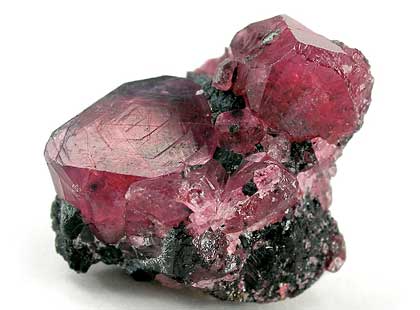
Cherry Red Ruby
A bit of matrix is host for 2 crystals of lustrous and translucent, cherry red ruby with exquisite micro-details on the faces and sharp bevelled edges. The larger one, exhibiting superb crystal form, measures 1.5 cm across. [3]
The characteristics of Ruby
Rubies are known to display fluorescence, of a mild glowing effect after the gem has been targeted with direct illumination by ultraviolet light. This effect is a result of the presence of chromium inclusions, the same element giving Rubies their iconic red color. Pleochroism has also been noted in Rubies, where two or more different colors are visible when viewing the gemstone at different angles.
Cut and Clarity for the July birthstone
Rubies are expected to have at least minor inclusions, though it is preferred to have minimal. You’ll find Rubies cut into multiple shapes, though the crystal formations are highly suited for flat hexagonal cuts such as oval and cushion. The crown of Rubies is typically brilliant cut while the facets are triangular or in a kite shape. It’s also common to find step cuts with rows of square or otherwise rectangular faceting. Other classic shapes include round, triangle, emerald cut, pear and marquise though these are typically found in smaller sizes if high quality. Large carats are typically uncommon in fine-quality varieties. If high-grade Rubies are found in large carat amounts, expense skyrockets and has broken auction records.
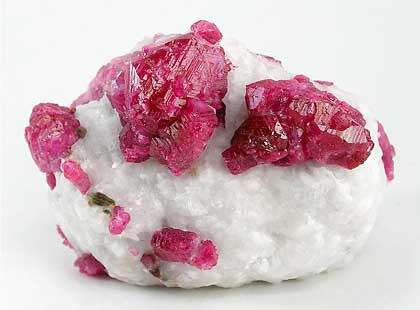
Cluster of Ruby the June Birthstone
This ruby specimen has multiple crystals with waxy red lustre and glow with color. Each cluster is about an inch across. The striations on the crystal faces increase the reflection of light. [4]
The value of Ruby
The deeper the color of a Ruby, the higher quality the gemstone is. A large transparent Ruby is rarer than even diamonds. The more transparent the gem is, the higher the quality is. While inclusions are typically a deterrent of value, some rubies exhibit asterism due to slender needle-like inclusions of rutile. Polished Rubies with asterism and high enough transparency to clearly see the star-like reflection are highly valued.
Is Ruby ever treated?
Rubies with less than desirable color such as brownish tones are often heat treated to improve color. The process of heat treating also increases the transparency of the gem by eliminating some tiny internal flaws. While heating is the most common method of treatment, it is also not entirely uncommon to find mildly dyed Rubies in the jewelry industry. Fracture-filling and cavity-filling can also be found as a treatment for Rubies though these tend to be considered far less valuable.
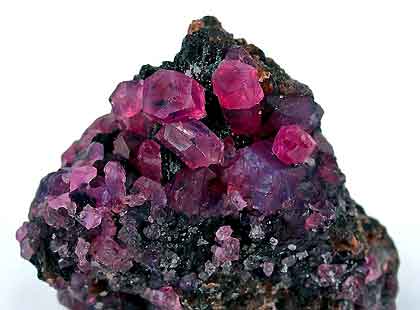
Ruby on Sapphire Matrix
Emplaced atop a matrix of massive sapphire are several lustrous and translucent, rose red ruby crystals. The overall effect of a small flower opening up is very pleasing. [5]
More about Ruby the July birthstone
Rubies are an incredibly hardy gemstone and do not exhibit a tendency of breaking if struck, also known as cleavage. This makes Rubies a favorite choice for rings since the gem stands up to daily wear.
While Rubies are only bested on the hardness scale by diamonds, the gem is still capable of chipping or fracturing internally. Especially gems fracture filled or dyed are susceptible to basic acids, even lemon juice.
The best method for cleaning Rubies is to use warm soapy water. Steam cleaners and ultrasonic cleaners tend to be safe as well, unless the gem has been fracture filled or dyed as the cleaning process may remove the treatment or exacerbate inclusions.
The American Gem Society's July Birthstone page has more information to help you buy from knowledgeable and skilled jewelers and to help you make the most informed buying decision.
Image Attribution
- By Parent Géry (Own work) [CC-BY-SA-3.0] via Wikimedia Commons
- Rob Lavinsky, iRocks.com – CC-BY-SA-3.0 [CC BY-SA 3.0], via Wikimedia Commons
- Rob Lavinsky, iRocks.com – CC-BY-SA-3.0 [CC BY-SA 3.0], via Wikimedia Commons
- Rob Lavinsky, iRocks.com – CC-BY-SA-3.0 [CC BY-SA 3.0], via Wikimedia Commons
- Rob Lavinsky, iRocks.com – CC-BY-SA-3.0 [CC BY-SA 3.0], via Wikimedia Commons
